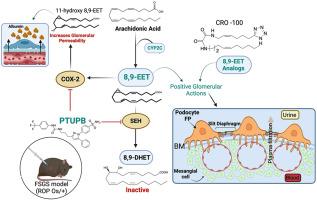Dual acting inhibitor of soluble epoxide hydrolase and Cyclooxygenase-2, attenuates glomerular injury in renal hypoplasia mice
IF 4.7
3区 医学
Q1 PHARMACOLOGY & PHARMACY
引用次数: 0
Abstract
Glomerular diseases like focal and segmental glomerulosclerosis (FSGS) are the leading cause of chronic and end-stage kidney diseases. Although FSGS is associated with high morbidity and mortality, available treatments are limited, which emphasizes the need for novel therapy. We developed a dual inhibitor, PTUPB, that concurrently acts as a soluble epoxide hydrolase (sEH) inhibitor and a cyclooxygenase-2 (COX-2) inhibitor. In the current study, we investigated renal actions of PTUPB in a genetic renal hypoplasia FSGS model, ROP Os/+ mice. ROP Os/+ mice developed albuminuria and glomerular injury between 16 and 20 weeks of age with an 8-fold higher albumin/Cr ratio than wild-type ROP +/+ mice. Three groups were assessed: 20-week-old ROP +/+ mice, ROP Os/+ mice treated with vehicle, and ROP Os/+ mice treated with PTUPB (10 mg/kg/d, i.p.). After 4 weeks, urine, blood, and kidney tissue were collected in the mice groups for biochemical, molecular, and histological analysis. ROP Os/+ mice had 10-fold higher albuminuria than ROP +/+ mice, and PTUPB treatment markedly attenuated albuminuria in ROP Os/+ mice by 69 %. ROP Os/+ mice developed a glomerular injury with a 3-fold higher glomerular injury score and 10-fold higher glomerular expression of sclerotic marker fibronectin than ROP +/+ mice, and PTUPB treatment attenuated these by 40–50 %. We further demonstrated that there was significantly lower renal mRNA expression of nephrin, podocin, podoplanin, synaptopodin, and glomerular WT1 immunopositive cells in ROP Os/+ mice which was improved by PTUPB treatment in these mice. Glomerular permeability studies in isolated glomeruli determined that COX-2 metabolites of 8,9-epoxyeicosatrienoic acid (EET) increased glomerular permeability. PTUPB, 8,9-EET, or 8,9-EET analogs prevented angiotensin II-induced glomerular permeability and mesangial cell proliferation. These findings demonstrate that COX-2 metabolites harm the glomerulus, whereas 8,9-EET improves glomerular function. Lastly, kidney fibrosis and inflammation were increased in ROP Os/+ mice compared to ROP +/+ mice. PTUPB treatment to ROP Os/+ mice decreased kidney fibrosis and inflammation. These findings demonstrate that the dual inhibitor PTUPB that concurrently inhibits sEH and COX-2 is a potential treatment for FSGS and related glomerular diseases.

可溶性环氧化物水解酶和环氧合酶-2双作用抑制剂,减轻肾发育不全小鼠肾小球损伤
肾小球疾病如局灶性和节段性肾小球硬化(FSGS)是慢性和终末期肾脏疾病的主要原因。虽然FSGS与高发病率和死亡率相关,但可用的治疗方法有限,这强调了对新疗法的需求。我们开发了一种双重抑制剂PTUPB,它同时作为可溶性环氧化物水解酶(sEH)抑制剂和环氧化酶-2 (COX-2)抑制剂。在本研究中,我们研究了PTUPB在遗传性肾发育不全FSGS模型ROP Os/+小鼠中的肾脏作用。ROP +/+小鼠在16 ~ 20周龄出现蛋白尿和肾小球损伤,白蛋白/铬比野生型ROP +/+小鼠高8倍。试验分为三组:20周龄ROP +/+小鼠、载药组ROP Os/+小鼠和PTUPB (10 mg/kg/d, i.p.)组ROP Os/+小鼠。4周后,收集各组小鼠尿液、血液和肾脏组织进行生化、分子和组织学分析。ROP Os/+小鼠的蛋白尿比ROP +/+小鼠高10倍,PTUPB治疗可显著降低ROP Os/+小鼠的蛋白尿69%。与ROP +/+小鼠相比,ROP Os/+小鼠发生肾小球损伤,肾小球损伤评分高3倍,肾小球硬化标志物纤维连接蛋白表达高10倍,而PTUPB治疗可使这些损伤减轻40 - 50%。我们进一步证明,在ROP Os/+小鼠肾脏中,nephrin、podocin、podoplanin、synaptopodin和肾小球WT1免疫阳性细胞的mRNA表达显著降低,PTUPB治疗可改善这些小鼠的mRNA表达。对离体肾小球的渗透性研究表明,COX-2代谢产物8,9-环氧二碳三烯酸(EET)增加了肾小球的渗透性。PTUPB、8,9- eet或8,9- eet类似物可阻止血管紧张素ii诱导的肾小球渗透性和系膜细胞增殖。这些发现表明COX-2代谢物损害肾小球,而8,9- eet可改善肾小球功能。最后,与ROP +/+小鼠相比,ROP Os/+小鼠肾纤维化和炎症增加。PTUPB治疗ROP Os/+小鼠可减轻肾纤维化和炎症。这些发现表明,同时抑制sEH和COX-2的双重抑制剂PTUPB是FSGS和相关肾小球疾病的潜在治疗方法。
本文章由计算机程序翻译,如有差异,请以英文原文为准。
求助全文
约1分钟内获得全文
求助全文
来源期刊
CiteScore
9.00
自引率
0.00%
发文量
572
审稿时长
34 days
期刊介绍:
The European Journal of Pharmacology publishes research papers covering all aspects of experimental pharmacology with focus on the mechanism of action of structurally identified compounds affecting biological systems.
The scope includes:
Behavioural pharmacology
Neuropharmacology and analgesia
Cardiovascular pharmacology
Pulmonary, gastrointestinal and urogenital pharmacology
Endocrine pharmacology
Immunopharmacology and inflammation
Molecular and cellular pharmacology
Regenerative pharmacology
Biologicals and biotherapeutics
Translational pharmacology
Nutriceutical pharmacology.

 求助内容:
求助内容: 应助结果提醒方式:
应助结果提醒方式:


